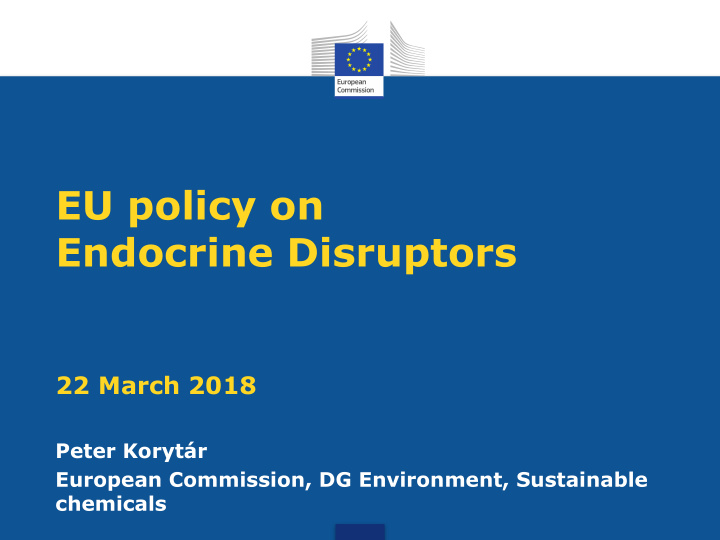



EU policy on Endocrine Disruptors 22 March 2018 Peter Korytár European Commission, DG Environment, Sustainable chemicals
EU policy on EDs: Where does it come from? October 1998 Parliament resolution Call to COM to take specific action December 1996 European workshop on the impact of EDs on human health and wildlife, Weybridge March 1996 ED hypothesis December 1999 2 Community Strategy for EDs
Policy on EDs • To minimise exposure to endocrine disruptors • further develop and implement approaches to effectively address safety concerns related to EDs in all relevant Union legislation; • increase efforts to ensure that, by 2020, all relevant substances of very high concern, including substances with endocrine-disrupting properties are placed on the REACH candidate list; • develop harmonised hazard-based criteria for the identification of EDs; 3
Legislation regulating EDs • Multiple pieces of chemical legislation in place safeguarding also from ED effects • Specific legal provisions on EDs • Water Framework Directive (2000) • REACH (2006) • Plant Protection Products Regulation (2009) • Biocidal Products Regulation (2012) • Regulation on Medical Devices (2017) • Proposal for Drinking Water Directive (2017) 4
Legislation on PPP and BP: New scientific criteria for EDs • Biocides • Applicable from 7 June 2018 to new and on-going applications • Pesticides (plant protection products): • Under scrutiny of EP and Council (8 January to 9 April 2018) • If not opposed, COM will adopt the criteria and they will be applicable from November 2018 onwards to new and on-going applications 5
Legislation on PPP and BP: New scientific criteria for EDs Adverse effect Endocrine mode Causality /Correlation of action (WHO/IPCS definition 2009) • All available scientific information: in-vivo, in-vitro, in-silico (read-across); standard studies (data requirements) & other scientific data (no hierarchy) • Animal evidence considered for HH (unless otherwise proven) • Weight of evidence 6
Implementation of the ED criteria • Development of a joint EFSA/ECHA guidance on the implementation of the criteria • Public consultation (Dec 2017 – Jan 2018) • Workshop with member states and stakeholders on the applicability of the guidance (Feb 2018) • Final guidance document is expected in mid of 2018 7
Development of test guidelines Achievements under OECD • Some 13 test guidelines developed specifically for EDs • Conceptual Framework for Testing and Assessment of EDs • Guidance Document No. 150 on Standardised Test Guidelines for Evaluating Chemicals for Endocrine Disruption Gaps remain in the test methods 8
Development of test guidelines • Projects finalised • Workshop on thyroid disruption • Development of DRP on retinoid signaling pathway • Temporal aspects in the testing of chemicals for endocrine disrupting effects • Setting priorities for further development and validation of test methods and testing approaches for evaluating endocrine disruptors 9
Development of test guidelines • Improvement of test methods for thyroid disruption • In vitro • In vivo • Enhancing scientific development in test methods • Horizon 2020 research call • TOPIC: New testing and screening methods to identify endocrine disrupting chemicals • Deadline: 18 April 2018 • http://ec.europa.eu/research/participants/portal/desktop/en/ opportunities/h2020/topics/sc1-bhc-27-2018.html 10
Thank you for your attention
Recommend
More recommend